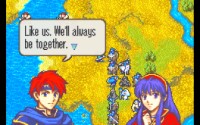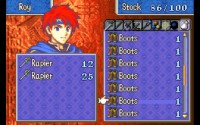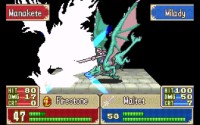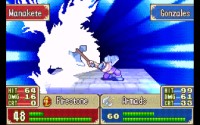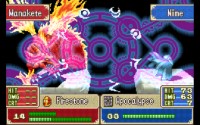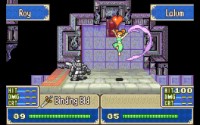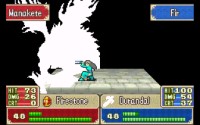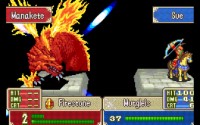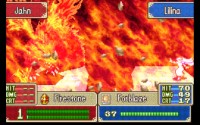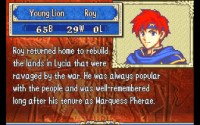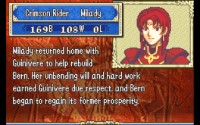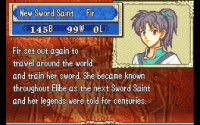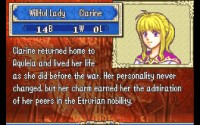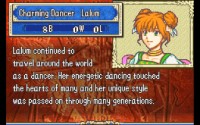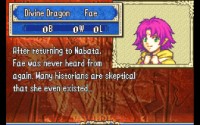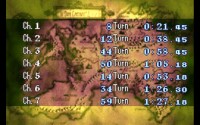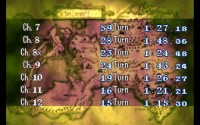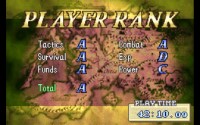Fire Emblem GBA
Since my most recent full playthroughs of FE7 and FE8 were done quite a while before writing this entry, my comments are probably a bit vague and my knowledge about the game could also be somewhat inaccurate. I've probably also missed some crucial details about things I particularly liked or disliked as a result - only FE6 has any details about these points. Also, I unfortunately did not have any screenshots taken/saved from my FE7/8 playthroughs, so the screenshots are exclusively from my FE6 playthrough.
FE6 Playtime: 44.5 Hours
Finished 20 February 2023.First playthrough, Normal mode. Since this was not officially released in English, I played an unofficial translation by gringe, available here (link is only for the ROM patch). I emulated the game on the Steam Deck, and like the others, did use savestates and resets relatively frequently as well (which makes this a baby mode playthrough I guess). I took the A route for both path splits (recruited Larum as a dancer in the West Isles, and went to Ilia after liberating Etruria), and did all of the sidequest chapters, unlocking the true ending (got the best ending with Roy finishing off Idunn). Because of some fun Silver Card/Member Card shenanigans to get a ton of Boots, I had almost a full 10-mov army for the last chapters, which particularly made Chapter 24 extremely trivial. Several of my units, including (especially) Lilina, Gonzalez, Fir, Sue, Melady, and Shanna were very blessed with great growths. Overall, I had a great time with this game too, but given some irritations with certain chapters or mechanics (that were fixed in FE7/8), I think this is my least-liked of the GBA series and I'm not really sure if I'd want to play this again any time soon. Don't regret playing it all though! Was absolutely worth experiencing it at least once.
The final playtime in the last screenshot is inaccurate to the actual playtime in the savefile for some reason - presumably, it's only counting up to Chapter 22 and ignoring playtime for the last 3 True Ending chapters?
FE7 Playtime: 32 Hours
Finished 25 February 2022.This was a first playthrough, so it was entirely on Normal mode. Did Lynmode and the Eliwood route, which unlocks Eliwood Hard + Hector Normal + ability to skip Lynmode. Not sure if I'll actually do any of those someday though; I loved the game but not planning another playthrough for now. Played on emulator, so I did reset or savestate very frequently during missions for the sake of keeping everyone alive, to pair them together (where possible) at the end of the game. Oswin got some great growths as a general so I gave him the boots to aid his rampage. Lyn turned out extremely well (probably because of Lynmode), Eliwood was OK and Hector sucked in this run.
FE8 Playtime: 28.5 Hours
Finished 19 March 2022.This was the first playthrough on the ROM I used, didn't save any old saves from previous emulator runs. I know I've played at least half of the game when I was much younger, but don't remember if I ever finished it (I did recall the ending though, so maybe?). Did Eirika's route on Normal difficulty, which might have been a slight mistake because it was pretty easy. Recruited all characters that I could in the main story, but didn't bother with any postgame stuff for the bonus characters or dungeon. I think the boots went to Amelia or Gilliam this time, but not entirely sure - I remember using generals a lot in this run too, partially because I always like doing that, but also in part because of how incredible Oswin was in FE7. Eirika had some extraordinary growths in this run from what I remember, didn't use Ephraim very much on the other hand since I didn't do his route. Tana was also extremely good if I remember correctly. I know the trainees aren't considered very good, but I still managed to get some good use out of Ross (Berserker) and Amelia (General). Like FE7, I had a great time but I'm not sure if I'm interested in planning out another playthrough in the near future.
The GBA Fire Emblem games are all very similar to one another; unlike the older games, the GBA games use a 2RN system that essentially "fudges" rolls to make true hit/miss probabilities far more extreme. It's pretty hard to mention any one of them without lumping in the others, since they play so similarly, unlike most other eras of FE games. The stories are quite simple, and I don't think they're particularly special. All that I know is FE8 is a self-contained story, while FE7 is a prequel to FE6 set about a generation earlier (for example, Eliwood is an middle-aged or older man in FE6). Despite being fairly simple stories, I enjoyed the plots of each game well enough. They generally follow the "evil dragon" formula brought up consistently throughout the rest of the series, so there aren't any surprises there. However, some of the character motivations and relationships were quite interesting, especially given how limited the dialogue is in these games. To that end, I actually appreciate that the plot is short and sweet - it means that I spent probably about 80-90% of my time in these games thinking about strategy, rather than spending copious amounts of time on the support pairings and marriages of the 3DS games or romping around in the monastery of 3H. Down the line, I can easily imagine that this would be my long term go-to era of games to replay frequently under different challenge conditions, because there are no other strings attached to the pure gameplay itself.
The gameplay design, as mentioned above, is much simpler than more recent titles. The games basically just take you through map after map, but there was still a decent variety of objectives. Most chapters tend to be rout, with a number of seize chapters and infrequent defend chapters. There are also a couple of other chapters with very unique objectives, like destroying a bunch of gorgon eggs in Ch18 of Sacred Stones (considered a rout, but mostly means you have to destroy the eggs before they hatch). Since reclass options are far more static compared to 3DS+ games, each of the units that you get serves real purpose, and there is less opportunity for replacing units at will via reclassing. Units that you get vary significantly in quality, though - there are some that feel completely redundant (like Marisa) and others that are a little too good (like Seth). As a running theme among these games, the cavaliers and fliers are still a bit overpowered and nobles/knights are too good growth-wise - I wish there was more reason to use some of the worse units, though I usually try to balance out my party anyway as a mini-challenge. Outside of the above points, FE8 also has one of the first proper overworlds of the series, with the option to revisit previous chapter locations for shopping and to do randomly-spawning skirmishes against the dark forces. FE8 has postgame content as well, with a few postgame dungeons/towers that can be used to grind or as an extra challenge towards maxing out characters - I didn't really feel compelled to do them, but apparently they're pretty good.
The visuals and audio are one of the most distinctive aspects of these games. The extremely old pixel graphics have a charm that has yet to be replicated in any modern era, to the point that even modern systems will still use that style of overworld/map sprite (3H uses a little Byleth pixel figure on the loading screens). All of the combat animations are incredible in their fluidity and impact - it's probably the closest that the GBA has ever come to properly approximating the power of these attacks. In particular, a lot of the crit animations really feel like someone is getting their face crushed with a super crunchy explosion sound effect. Speaking of sound effects and audio, I love the music and audio design for these games - there's no vocal track or whatever like in the newer games but it's not necessary.
There's not much else that I can say about the games right now, since I'm mostly going off of my memory from my playthroughs that are over a year ago at this point. But with all being said, I love these games; I grew up playing Sacred Stones, and neither that nor FE7 are really old for me yet. I would do GBA FE playthroughs more frequently if I didn't already have a ton of other games I wanted to try. But I'll definitely come back to these someday.
Follow-up after finishing FE6:
After finishing FE6, I think it's probably the game that I like the least out of the GBA games, but it's still quite fun. Most of the above comments about the general gameplay and audiovisual aspects still apply to FE6 - I really like the overall presentation of this game, just as I do FE7 and FE8. Most of my complaints about this game are issues that I have with specific mechanics or balancing decisions that were changed through the other 2 games, presumably after some degree of playtesting or player feedback. With that in mind, I think my experience was definitely spoiled by the better (in my opinion) FE7 and 8 - from what I understand, some mechanics in those games were also adjusted for the overseas market as well, which likely has some additional impact. As another note, I don't know how good or bad the translation patch I used is, but I felt it was perfectly intelligible and I didn't care too much for the exact quality of dialogue anyway - the plot of this game is just as simple as the others so I believe it would make no difference in my overall opinion.
To start, the first major difference I noticed about FE6 was the constantly low hitrates, which is something I've seen referenced quite frequently in passing online when comparing the GBA titles. For some reason I thought this game was also using a 1RN system instead of the 2RN true hit system used by the other games - I know that this is inaccurate though, and all the GBA games use 2RN. Very few units managed to reach a consistent 100 Hit in combats - outside of Fir, Shanna, and occasionally Sue and Lilina, most hitrates tended to hover around 80-90 at maximum, even with near-capped Skill at the end of the game. Lances and axes suffer especially hard, with the latter almost never managing to approach reasonable hitrates unless attacking with triangle advantage. On the other hand, that means this game is generally very sword-friendly; most have Hit values so high that 100% is achievable even at a disadvantage, making them very solid in this game in comparison to their more diminished role in the others (especially FE7). I did still have my fair share of unfortunate 10-20% hits from enemies - much more than I'd expect at a glance - but I'm pretty sure it matched well with the True Hit system. As would be expected, I had some instances of both great and terrible luck - a particular high point in my mind is Fir hitting 9 out of 10 Light Brand ranged strikes on Zephiel with 54 displayed hit, an absurdly unlikely sequence. I also dodged 3 88-accuracy Berserk staff attempts from a Druid onto Gonzalez in another chapter - I believe staves use 1RN, but that's still a 0.1% chance right there.
On the other hand, I had an extremely strange experience with Crit rolls being far worse than displayed in this game, which I don't recall being an issue in the other games. With killer weapons, most units average about 30-40 displayed crit, but with a sample size of over 100, I saw a real rate closer to a pathetic 15-20%. Even with the Swordmaster's and Berserker's massive Crit bonus of +30 in this game, a displayed 60-70% crit was still observed to have a real chance closer to 40-50%, again with a decent sample size. It only finally started to feel consistent once Fir reached close to 80% with the Wo Dao, yet that still wasn't anywhere near the promised rate. Note that Crit in the GBA games uses only 1RN (and I believe is only rolled after a successful 2RN hit), else Berserkers and especially Swordmasters would essentially be hitting nothing but crits by endgame. I don't think I can really explain this through any means other than that the displayed rates are incorrect or bugged. That said, while the lower-than-displayed crit is aggravating, it also applied to enemies as well, who didn't land a single crit with a killer weapon the entire game somehow - the only crits came from random myrmidons or mercenaries with regular weapons from what I remember.
Also contributing to the slower dynamic of the game is the player-side unit quality, which is quite a bit worse in general than the other GBA games. Growth rates are generally far lower in this game, leading to generally inconsistent unit growths and overall lower stats. On one hand, it allows many units to contribute for multiple chapters in a row without instantly falling behind, but it also means that the outcomes of each unit vary wildly. For example, Lugh got almost no magic growth with about 6 Mag by Level 12, while Lilina had probably about 16 at that point, and hit the unpromoted 20 Mag cap by Level 17. Defensive stat growths are particularly bad, with most units never evolving far beyond their bases - Lance had a miserable 8 defense as a promoted Lv16/1 Paladin, and both Allen/Lance had less than 5 Res at that level. In comparison, Perceval joined somewhat earlier with a solid 14Def/11Res and comparable offensive stats, giving very little reason to continue training the other cavaliers which are objectively worse. Even Igrene, a lategame sniper unit, outclasses them in this aspect, joining with something like 10Def/11Res which isn't even particularly good at that point. The inability of almost all units to take punishment (compare to Oswin/Hector in FE7, or Gilliam/Seth in FE8) naturally slows the pace of the game down a lot, where unit exposure to enemy squads needs to be very carefully managed to avoid enemy suicide attacks. Thankfully, unit strength growth generally fares a little better on average so the low durability is compensated for by very reasonable killing power near the end of the game with only a very small set of units resisting 1 round kills. A final complaint for now is that statbooster items in this game cannot be used in the pre-Chapter deploy menu, so those items must be carried into battle in lieu of a weapon or more useful equipment. As a result, a lot of statboosters that could have been useful were not used until near the end of the game, which probably added little bits of difficulty that I wouldn't have to deal with otherwise.
I want to go into a bit more detail on a select few units who were especially notable in my run (obviously not representative of averages). Roy simply sucks - for arbitrary story purposes, they made you deal with a horrible 5 Mov for 90% of the game, all the way until the very last Chapter pre-True End route. His growths are middling but it's very hard to feed him any significant amount of XP, especially starting around Ch.14, where the newly-promoted army begins to completely outpace him. You get one pair of boots before Chapter 21, but those will always go to Larum/Elffin since they are actually valuable. To be fair, mediocre lords are pretty much standard in the GBA games. Thankfully, in my run, I was lucky enough to get a very solid supporting cast to carry him to victory. Lilina had absurdly good growths, with the expected Mag cap but also extremely good Spd and solid Luck, turning her into a boss nuke for the entire game. Fir started out slow, but eventually received very good Strength (21+), near-perfect Skl and Spd, and enough Lck to hit everything while very rarely getting attacked in return - the +30 crit from the swordmaster promotion certainly helped as well. Gonzalez also capped Str and Spd, and even managed to get a respectable Skl growth, managing to almost hit 20 by the last chapters with one Skill Book. Even with the axes in this game having poor Hit, he could usually breach the 80 Hit boundary - and even if he missed once, the +30 Crit gave him a solid chance to knock them flat with a crit anyway. Sue was a very solid archer with enough strength to one round even some really beefy enemies, and enough resistance to tank a few mage hits. Lastly, Melady was insanely good in my run - she got enough good level ups to cap Str, Skl, Spd, AND reach almost 20 Def with no statboosters, all on top of a unit that has a natural 8 Mov and massive terrain traversal advantages. With a Delphi Shield (and avoiding mages), she is the sole exception to my "no tanky units" experience in this game - entire squads could fly into her and melt, while she would be able to both dodgetank and hardtank any punishment coming her way. I usually had her solo entire parts of the map herself because I knew she wouldn't really take much damage anyway. Aside from all those, a few mentions should go to Perceval (solid unit with mediocre growths, but that didn't matter), Shanna (very good all around, just not as bulky as Melady for endgame), Tate (almost-as-good-as-Shanna), Igrene (very useful in every chapter I deployed her), Niime, Larum, and Clarine. I'm really thankful that I was able to get enough great units in my run to make the endgame a breeze.
The enemies in this game are thankfully pretty mediocre as well, so the worse units don't make the game particularly difficult or anything. I guess some of the comparison could come down to the fact that the enemies didn't get any harder for FE7/8 while units got significantly better, which makes those games overall much easier than this one. With that being said, many of the late chapters still had low-level promotes as squad leader units and Lv20 unpromoted units as common units, which were nothing compared to my mostly mid-10s promoted units. Just like the other GBA titles, the end of the game boiled down again to a game of "who do I want to give this kill?", rather than "who can get this kill?" - in that respect, it's not that different from 7 and 8. Still, I think some more time and care was put into balancing the unit formations in this game, since plenty of them had interesting loadouts - Reavers, Killers, Armor/Horseslayers, etc. were fairly common on soldiers and Aircalibur was common on mages to take down fliers, requiring a bit more strategy than mindlessly rushing everything. Unfortunately, this care didn't extend to chapter bosses. Note that every single chapter in this game invariably uses a "Seize" objective, so there is always a stationary boss at the end, no matter their class type or weapon range. This was very easy to exploit - many maps had bosses with 1 range weapons equipped, which could be easily whittled down or straight up bombed by Lilina. This basically made them XP farms if I needed a level on someone. One of the only exceptions to this is Zephiel, who is pretty much the antithesis of the other easy bosses - with the Throne bonus, his defenses are so absurdly high that he's pretty much impossible to damage, which is especially funny design-wise since my units completely mopped the floor with everyone else in his castle. For some reason (probably a programming oversight?), he doesn't count as an armored class, and receives no extra damage from Hammers/Slayers - which is basically just bad design. Because of how poorly designed that fight is in general, I didn't really feel bad for preparing to savescum Fir's Light Brand hits on him. Thankfully, she landed something like 9/10 required hits so I didn't really have to do much - but I know that's an incredibly unlikely outcome for 54 displayed Hit. Note that every boss after him (including the final boss!) died in one turn, with Roy requiring a refresh to double Idunn since he was too slow (2 strikes total).
There were some weird quirks to enemy deployment in the maps of this game as well, which added additional challenges annoying me quite a bit. First and foremost, this game always uses ambush spawns unlike FE7 (Lynmode has ambushes but Eliwood/Hector don't) and FE8 (no ambushes at all) - they are TERRIBLE and made me feel a lot less guilty about spamming savestates pretty liberally on maps where they were particularly awful, like the infinite Wyvern/Paladin spam in Chapter 21. I wish they could have struck a balance, allowing spawns to move immediately but not attack. This could allow the AI to be more dynamic, either adding additional pressure to your units and impeding forward progress by running directly into your troop formation, or reinforcing other squads on the map to provide more comprehensive coverage of a position, making it harder for your troops to breach. On the other hand, I think the infrequent reinforcements in this game could be mostly attributed to the nature of the AI - this game would be almost unplayable IMO if maps were more heavily reinforced. Other minor gripes include the common use of ballistas to completely zone out fliers in several chapters - without Milady + Delphi Shield, I imagine some maps would be a nightmare to play. There's no payoff either, since player units cannot interact with ballistas - they are an enemy-only construct which is really stupid. I feel similarly about the frequent use of siege tome users in inaccessible locations, which again just slows down the game further. And lastly, I found the frequent use of Sleep/Berserk staff formations incredibly annoying too, especially since it seems like deployment order actually has an effect on enemy priorities - for a while, all the enemy druids tried sticking a low-accuracy sleep on Niime to my amusement.
On the topic of encounter design, the quality of the maps in this game is middling at best. Most of them are fine, if somewhat unmemorable - but there are some real stinkers that make me never want to do another playthrough of this game again. For example, Chapter 8 (Castle Ostia) requires the entire party follows a single narrow path around the entire map, resulting in about half of the turns consisting entirely of just pushing every unit up and no fights. Chapter 14 (Arcadia, Nabata Desert) is a fog-of-war desert map, which is a self-explanatory sin. 14x is also awful, with the water bridges collapsing starting from turn 2, requiring you to wait until about Turn 8/9 before you can actually continue playing the map. Chapter 22 (Castle Bern) has a button very far out of the way, resulting in about 7 turns of just watching 4 units traveling slowly there to hit it, while everyone else waits awkwardly at the door to the throne room. Aside from these, there are also 2 maps that I played that had time-locked terrain changes: in 17A, a sandbar appears connecting the starting area to the seize point, and in 18A the rivers freeze eventually, allowing for free traversal. These take too long to take effect - by the time they happened, I was already pretty much there on the regular path. I think they should have been triggered faster to make the change more impactful, but it's not a huge deal one way or the other. Most of the other maps are OK terrain-wise, but some (like Ch.21) are more annoying because of reinforcements, enemy positioning, etc. There's also some issues with turn limits on a number of maps to be eligible for sidequest chapters where you gather the legendary weapons, required for the true ending; thankfully, none of those turn limits were particularly difficult to reach - maybe this is different on Hard mode but I'll never know.
The issues with several of the maps were probably exacerbated by a number of unit recruitment conditions being absolutely awful in this game, which I don't remember being as much of a problem in the GBA sequels. The most notable is probably Cath, a thief that appears in almost every map with a number of chests in this game. To recruit her, you need to talk to her with Roy across 3 maps in which she spawns. Note that this is pretty much impossible to do reasonably since Thieves have 6 Mov in this game (and Roy is stuck with 5), so you have to extremely far out of your way to do this with a guaranteed loss of several chests' contents, which are far more valuable than another useless thief unit. You can't even steal those items back, since gold is simply gone and you can't steal unequipped weapons in this game. It's simply an awful condition that exists solely for the sake of being awful - she spawns too far away for you to ever catch with Roy in Chapter 8 without putting the rest of your army at high risk, so there is simply no reason to keep her alive. In hindsight, I should have killed her the first time I saw her; the silver lance that I would have gotten if she didn't steal it is worth more than she is.
The entirety of Chapter 11A is also rife with these. Firstly, recruiting Klein is a pain in the ass because he is an ambush spawn - if you have Clarine in position, he will instantly move to her and kill his own sister instead of talking for some reason - you need to have Clarine talk to him during Player phase. Even after you recruit him, recruiting Tate/Thea is another awfully-designed condition; you have to have Klein walk all the way across the ENTIRE MAP to get to her, which wastes another ~8-10 turns. Thankfully, you can get Tate to turn from enemy to NPC by talking to her with Shanna, else Tate will attack and suicide on Klein (who she's working for, to be clear), which is the dumbest possible game design. This still requires that Shanna dodgetanks the entire flight of Pegasus Knights without counterkilling any of them - again, awful design. Even recruiting Echidna is terrible, since she appears with an ambush spawn of 4 fighters. If you're waiting to recruit her, those 4 fighters will get free attacks on anything nearby (which resulted in Larum dodging 3 axes). This map really didn't feel particularly well playtested - I think they would have seen the value of avoiding ambush spawns if they had even trialed the map once before releasing it.
The last block of horrible recruitments is in Chapter 16 (Aquileia, Castle Etruria), which is dumber by design but a little less annoying in practice than Chapter 11A. Zeiss is in an out-of-the-way corner of the map and is stuck behind a wall, but he isn't actually much of a problem. However, recruitment of Hugh and Douglas mostly comes down to some awful design choices. Hugh is a pretty mediocre filler mage unit that requires 10K gold to be recruited, and needs to talk to Roy, who has a locked spawn at the bottom left entrance of the castle. However, since there is a locked door on the left side, Hugh will start winding all the way to the right side of the map immediately (instead of staying put, etc.), meaning you have to go out of your way to ferry Roy in order to recruit Hugh, which again also requires a massive gold investment for a pretty shitty unit. There's really no reason to recruit him - his only purpose is to let a thief steal his Member Card then let someone else kill him for a small nugget of EXP, which contributes more than he ever would have. Douglas, the other recruit, is a prepromoted general who instantly aggros and chases your units around the entire chapter, with no way to turn him neutral. You have to keep him alive to access the sidequest, which requires some really annoying finesse because he isn't even particularly good - Fir almost killed him on accident when counterattacking. Note that this is a map with pretty heavy reinforcement spawns and a lot of chests to loot (and a time limit!), all of which contribute to the sheer irritation of dealing with Douglas's dumbass mechanic. If keeping him alive wasn't required for the sidequest I would kill him in a heartbeat. Dealing with all of these shitty recruitments in this chapter (and in 11A) pretty much ruins what would otherwise be decent maps - it's not like those maps have terrible terrain or enemy spawns.
